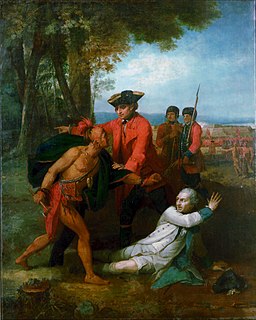 W
WThe Battle of Lake George was fought on 8 September 1755, in the north of the Province of New York. The battle was part of a campaign by the British to expel the French from North America, in the French and Indian War.
 W
WThe Charter Oak was an unusually large white oak tree growing on Wyllys Hyll in Hartford, Connecticut in the United States, from around the 12th or 13th century until it fell during a storm in 1856. According to tradition, Connecticut's Royal Charter of 1662 was hidden within the hollow of the tree to thwart its confiscation by the English governor-general. The oak became a symbol of American independence and is commemorated on the Connecticut State Quarter. In 1935, for Connecticut's tercentennial, it was also depicted on both a commemorative half dollar and a postage stamp.
 W
WThe Fairfield Swamp Fight was the last engagement of the Pequot War and marked defeat of the Pequot tribe in the war and the loss of their recognition as a political entity in the 17th century. The participants in the conflict were the Pequot and the English with their allied tribes. The Fairfield Swamp Fight occurred July 13–14, 1637 in what is present-day Fairfield, Connecticut. The town of Fairfield was founded after the battle in 1639.
 W
WThe exact date of the first African slaves in Connecticut is unknown, but the narrative of Venture Smith provides some information about the life of northern slavery in Connecticut. Another early confirmed account of slavery in the colony came in 1638 when several native prisoners were taken during the Pequot War were exchanged in the West Indies for African slaves. Such exchanges become common in subsequent conflicts.
 W
WThe Mystic massacre took place on May 26, 1637 during the Pequot War, when Connecticut colonists under Captain John Mason and their Narragansett and Mohegan allies set fire to the Pequot Fort near the Mystic River. They shot anyone who tried to escape the wooden palisade fortress and killed most of the village in retaliation for previous Pequot attacks. The only Pequot survivors were warriors who had been with their sachem Sassacus in a raiding party outside the village.
 W
WThe Pennamite–Yankee Wars or Yankee–Pennamite Wars were a series of conflicts consisting of the First Pennamite War (1769–1770), the Second Pennamite War (1774), and the Third Pennamite War (1784), in which the Wyoming Valley along the North Branch of the Susquehanna River was disputed between settlers from Connecticut (Yankees) and Pennsylvania (Pennamites).
 W
WThe Treaty of Hartford is a treaty concluded between New Netherland and Connecticut on September 19, 1650 in Hartford, Connecticut.
 W
WThe Wyoming Valley is a historic industrialized region of Northeastern Pennsylvania, once famous for fueling the industrial revolution in the United States with its many anthracite coal mines. As a metropolitan area, it is known as the Scranton/Wilkes-Barre metropolitan area, after its principal cities, Scranton and Wilkes-Barre, and is the 101st-largest metropolitan area in the United States and the 4th largest in Pennsylvania. It makes up its own unique physiographic province, the Anthracite Valley, in the geology of Pennsylvania. Greater Pittston makes up the center of the valley. Scranton is the most populated city in the metropolitan area with a population of 77,114. The city of Scranton has grown in population after the 2015 mid term census while Wilkes-Barre has declined in population. Wilkes-Barre is still the second most populated city in the metropolitan area and Hazleton is third. The airports for this area are Wilkes-Barre/Scranton International Airport (Avoca) and the Wilkes-Barre Wyoming Valley Airport.